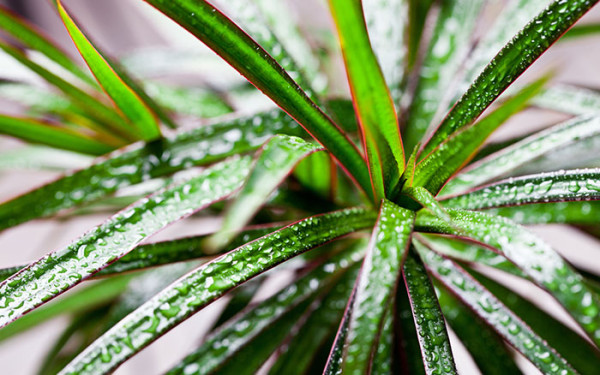There’s a houseplant for every home, and this is a popular plant for good reason. So, let’s learn a little more about Dracaena marginata or dragon tree, to see how you can incorporate it into your indoor garden.
All about dragon trees
The botanical name Dracaena originates from the Greek for ‘female dragon’. This has been said to refer to the sap that comes from the stems which is red in colour. Back in medieval times, the gum was used in magical arts, but today it’s most commonly used as a wood varnish.
They are striking indoor trees, that can have big impact. If you are low on floor space but still want to make a big impression using houseplants, opt for a plant that is tall and slim like Dracaena marginata (dragon tree). If you want to make a statement in a corner of the room, they are great for this too, or something like a Yucca elephantipes (yucca).
The foliage has subtle variegated colouring, with deep green leaves, edged with red along the lengths. There are other variations of colour too like tri-colour ones with pink, green, and yellow leaves so there’s sure to be a colour scheme that matches your interior design.
The fronds grow straight and then begin to arch with age, giving a softer appearance. But the palm-like appearance will still do the trick of making you feel like you’re in the tropics.

Caring for Dracaena marginata
When positioning your dragon tree, choose a spot that’s bright with indirect light. Too much light will damage the leaves. Water them regularly to keep the soil moist. Also, through growing season, give them a feed with a houseplant fertiliser.
They can be relatively slow growing, and can take around 10 years for them to grow to their ultimate size. Until this point, they may need repotting so they have sufficient space to grow. Every other spring, repot the dragon tree into a pot that’s slightly bigger than the previous one. Top up with peat-free houseplant compost.

More in store
Not only can this tree add structure to your interior, having a big impact, but they have another incredible function too. The leaves have the ability to filter benzene from the air. Benzene is a volatile organic compound (VOC) which comes from cigarette smoke and petrol fuelled cars – making it great for town and city houses. Filtering this hydrocarbon reduces the risk of various adverse health effects like headaches, drowsiness, and dizziness.
To keep the plant doing this effectively, it’s important to keep the long leaves clean. Do this by holding the plant still and using a wet cloth to gently wipe the leaves to rid any dust or debris. It’ll keep the plant looking fresh, and also allow it to filter these VOCs from the air, and also photosynthesise more effectively.

Now, I’m sure you can see why Draceana marginata is such a popular houseplant. With this guide, you’ll be well on your way to having a thriving indoor garden. For more tips on caring for houseplants, check out my book My Houseplant Changed My Life.
David Domoney is a Chartered Horticulturalist, Broadcaster, and Author. David has worked with a number of the UK’s leading garden retailers as a plant buyer and strategic consultant. With more than 30 years experience, in horticulture, David is as passionate about plants now as he was when he bought his first plant at a village fete.

Leave A Comment